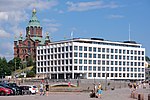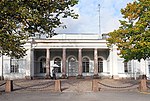Port of Helsinki
The Port of Helsinki (Finnish: Helsingin Satama, Swedish: Helsingfors Hamn) is one of the busiest passenger ports in Europe and the main port for foreign trade in Finland.For passenger traffic, the port operates regular liner connections to destinations such as Tallinn, Stockholm, Saint Petersburg and Travemünde, serving a total volume of 11.6 million passengers in 2018. Additionally, it is a popular destination for international cruise ships with 520,000 passenger arrivals in 2018.As Finland's leading cargo port, a total of 14.7 million tonnes of goods were transported in 2018. The main export commodities are products for the forest industry, machinery and equipment, whereas in imports the most prominent product group are daily consumer goods. In 2017, the Port of Helsinki acquired a majority stake in the Port of Loviisa, situated some 70 kilometres (43 mi) east of Helsinki.The port is owned by the city of Helsinki and operated by Port of Helsinki Ltd. The current port traffic volumes and urban population categorize Helsinki as a Large-Port City
Excerpt from the Wikipedia article Port of Helsinki (License: CC BY-SA 3.0, Authors).Port of Helsinki
Katajanokanlaituri, Helsinki Katajanokka (Southern major district)
Geographical coordinates (GPS) Address Website Nearby Places Show on map
Geographical coordinates (GPS)
| Latitude | Longitude |
|---|---|
| N 60.164722222222 ° | E 24.958333333333 ° |
Address
Allas Sea Pool
Katajanokanlaituri 2a
00160 Helsinki, Katajanokka (Southern major district)
Finland
Open on Google Maps











